Load Balancing Integrated Least Slack Time-Based Appliance Scheduling for Smart Home Energy Management
Abstract
:1. Introduction
2. Related Works
3. Load Shift Models
3.1. Appliance Loads
3.2. Cumulative Load Management
4. System Architecture
4.1. Modeling of Smart Home Appliances
4.2. LST Scheduler
| Algorithm 1 Algorithm for appliance scheduling |
| Variables: : collection of requests : request where : theoretical appliance power consumption corresponding to request : total power consumption of accepted requests : maximum power consumption threshold Goal: Initialize the request set in descending order of heuristic value for all do if task is non-preemptive and operational then accept request remove request from end if end for for all do if and request is operational then accept request remove request from end if end for for all do if then accept request remove request from end if end for |
4.3. Load Balancing
- Constraint 1: Total power consumption of a particular time slot should be limited to the allotted load capacity.
- Constraint 2: Allocate consecutive time frames to each request in all possible scenarios; this provides sufficient operational time and to finish the operational cycle within the deadline.
- Constraint 3: Schedule each task once only. Worthy to note that schedule number is subject to changes based on its requirements, characteristics, and priorities.
- Constraint 4: Schedule each task in the applicable operation period, such that it assures operation during a specific time period.
5. Results and Discussion
6. Conclusions
Acknowledgments
Author Contributions
Conflicts of Interest
References
- Silva, B.N.; Khan, M.; Han, K. Internet of Things: A Comprehensive Review of Enabling Technologies, Architecture, and Challenges. IETE Tech. Rev. 2017, 1–16. [Google Scholar] [CrossRef]
- Khan, M.; Silva, B.N.; Han, K. Internet of Things Based Energy Aware Smart Home Control System. IEEE Access 2016, 4, 7556–7566. [Google Scholar] [CrossRef]
- Catarinucci, L.; De Donno, D.; Mainetti, L.; Palano, L.; Patrono, L.; Stefanizzi, M.L.; Tarricone, L. An IoT-Aware Architecture for Smart Healthcare Systems. IEEE Internet Things J. 2015, 2, 515–526. [Google Scholar] [CrossRef]
- Jabbar, S.; Khan, M.; Silva, B.N.; Han, K. A REST-based industrial web of things’ framework for smart warehousing. J. Supercomput. 2016, 1–15. [Google Scholar] [CrossRef]
- Viswanath, S.K.; Yuen, C.; Tushar, W.; Li, W.-T.; Wen, C.-K.; Hu, K.; Chen, C.; Liu, X. System design of the internet of things for residential smart grid. IEEE Wirel. Commun. 2016, 23, 90–98. [Google Scholar] [CrossRef]
- Silva, B.N.; Khan, M.; Han, K. Big Data Analytics Embedded Smart City Architecture for Performance Enhancement through Real-Time Data Processing and Decision-Making. Wirel. Commun. Mob. Comput. 2017, 2017, 9429676. [Google Scholar]
- Son, J.Y.; Park, J.H.; Moon, K.D.; Lee, Y.H. Resource-aware smart home management system by constructing resource relation graph. IEEE Trans. Consum. Electron. 2011, 57, 1112–1119. [Google Scholar] [CrossRef]
- Abushnaf, J.; Rassau, A.; Górnisiewicz, W. Impact on electricity use of introducing time-of-use pricing to a multi-user home energy management system. Int. Trans. Electr. Energy Syst. 2016, 26, 993–1005. [Google Scholar] [CrossRef]
- Muller, A.; Bourdais, R. Dynamic Pricing for Local Energy Management: Towards a Better Integration of Local Production. IFAC-PapersOnLine 2017, 50, 6749–6754. [Google Scholar] [CrossRef]
- Qayyum, F.A.; Naeem, M.; Khwaja, A.S.; Anpalagan, A.; Guan, L.; Venkatesh, B. Appliance Scheduling Optimization in Smart Home Networks. IEEE Access 2015, 3, 2176–2190. [Google Scholar] [CrossRef]
- Khan, M.; Silva, B.N.; Han, K. A Web of Things-Based Emerging Sensor Network Architecture for Smart Control Systems. Sensors 2017, 17, 332. [Google Scholar] [CrossRef] [PubMed]
- Li, C.; Yu, X.; Yu, W.; Chen, G.; Wang, J. Efficient Computation for Sparse Load. IEEE Trans. Smart Grid 2017, 8, 250–261. [Google Scholar] [CrossRef]
- Muratori, M.; Rizzoni, G. Residential demand response: Dynamic energy management and time-varying electricity pricing. IEEE Trans. Power Syst. 2016, 31, 1108–1117. [Google Scholar] [CrossRef]
- Mnatsakanyan, A.; Kennedy, S.W. A novel demand response model with an application for a virtual power plant. IEEE Trans. Smart Grid 2015, 6, 230–237. [Google Scholar] [CrossRef]
- Muratori, M.; Schuelke-Leech, B.-A.; Rizzoni, G. Role of residential demand response in modern electricity markets. Renew. Sustain. Energy Rev. 2014, 33, 546–553. [Google Scholar] [CrossRef]
- Mohsenian-Rad, A.-H.; Wong, V.W.S.; Jatskevich, J.; Schober, R.; Leon-Garcia, A. Autonomous Demand-Side Management Based on Game-Theoretic Energy Consumption Scheduling for the Future Smart Grid. IEEE Trans. Smart Grid 2010, 1, 320–331. [Google Scholar] [CrossRef]
- Atzeni, I.; Ordóñez, L.G.; Scutari, G.; Palomar, D.P.; Fonollosa, J.R. Demand-Side Management via Distributed Energy Generation and Storage Optimization. IEEE Trans. Smart Grid 2013, 4, 866–875. [Google Scholar] [CrossRef]
- Joe-Wong, C.; Sen, S.; Ha, S.; Chiang, M. Optimized Day-Ahead Pricing for Smart Grids with Device-Specific Scheduling Flexibility. IEEE J. Sel. Areas Commun. 2012, 30, 1075–1085. [Google Scholar] [CrossRef]
- Ramanathan, B.; Vittal, V. A Framework for Evaluation of Advanced Direct Load Control with Minimum Disruption. IEEE Trans. Power Syst. 2008, 23, 1681–1688. [Google Scholar] [CrossRef]
- Shukla, R.M.; Kansakar, P.; Munir, A. A Neural Network-based Appliance Scheduling Methodology for Smart Homes and Buildings with Multiple Power Sources. In Proceedings of the 2016 IEEE International Symposium on Nanoelectronic and Information Systems, Gwalior, India, 19–21 December 2016. [Google Scholar]
- Adika, C.O.; Wang, L. Autonomous Appliance Scheduling for Household Energy Management. IEEE Trans. Smart Grid 2014, 5, 673–682. [Google Scholar] [CrossRef]
- Chen, X.; Wei, T.; Hu, S. Uncertainty-Aware Household Appliance Scheduling Considering Dynamic Electricity Pricing in Smart Home. IEEE Trans. Smart Grid 2013, 4, 932–941. [Google Scholar] [CrossRef]
- Pedrasa, M.A.A.; Spooner, T.D.; MacGill, I.F. Coordinated Scheduling of Residential Distributed Energy Resources to Optimize Smart Home Energy Services. IEEE Trans. Smart Grid 2010, 1, 134–143. [Google Scholar] [CrossRef]
- Chen, C.; Wang, J.; Heo, Y.; Kishore, S. MPC-Based Appliance Scheduling for Residential Building Energy Management Controller. IEEE Trans. Smart Grid 2013, 4, 1401–1410. [Google Scholar] [CrossRef]
- Zhao, Z.; Lee, W.C.; Shin, Y.; Song, K.-B. An Optimal Power Scheduling Method for Demand Response in Home Energy Management System. IEEE Trans. Smart Grid 2013, 4, 1391–1400. [Google Scholar] [CrossRef]
- Chen, C.; Nagananda, K.G.; Xiong, G.; Kishore, S.; Snyder, L.V. A Communication-Based Appliance Scheduling Scheme for Consumer-Premise Energy Management Systems. IEEE Trans. Smart Grid 2013, 4, 56–65. [Google Scholar] [CrossRef]
- Liu, Y.; Yuen, C.; Huang, S.; Hassan, N.U.; Wang, X.; Xie, S. Peak-to-Average Ratio Constrained Demand-Side Management with Consumer’s Preference in Residential Smart Grid. IEEE J. Sel. Top. Signal Process. 2014, 4, 1084–1097. [Google Scholar] [CrossRef]
- Kumar, P.T.V.B.N.; Suryateja, S.; Naveen, G. Smart home energy management with integration of PV and storage facilities providing grid support. In Proceedings of the 2013 IEEE Power and Energy Society General Meeting, Vancouver, BC, Canada, 21–25 July 2013. [Google Scholar]
- Tsui, K.M.; Chan, S.C. Demand Response Optimization for Smart Home Scheduling Under Real-Time Pricing. IEEE Trans. Smart Grid 2012, 3, 1812–1821. [Google Scholar] [CrossRef]
- Yi, P.; Dong, X.; Iwayemi, A.; Zhou, C.; Li, S. Real-time opportunistic scheduling for residential demand response. IEEE Trans. Smart Grid 2013, 4, 227–234. [Google Scholar] [CrossRef]
- Mirabbasi, D.; Beydaghi, S. Optimal scheduling of smart home appliances considering PHEV and energy storage system. In Proceedings of the 2015 4th International Conference on Electric Power and Energy Conversion Systems, Sharjah, United Arab Emirates, 24–26 November 2015. [Google Scholar]
- Vlot, M.C.; Knigge, J.D.; Slootweg, J.G. Economical regulation power through load shifting with smart energy appliances. IEEE Trans. Smart Grid 2013, 4, 1705–1712. [Google Scholar] [CrossRef]
- Esther, B.P.; Kumar, K.S. A survey on residential demand side management architecture, approaches, optimization models and methods. Renew. Sustain. Energy Rev. 2016, 59, 342–351. [Google Scholar] [CrossRef]
- Zhou, B.; Li, W.; Chan, K.W.; Cao, Y.; Kuang, Y.; Liu, X.; Wang, X. Smart home energy management systems: Concept, configurations, and scheduling strategies. Renew. Sustain. Energy Rev. 2016, 61, 30–40. [Google Scholar] [CrossRef]
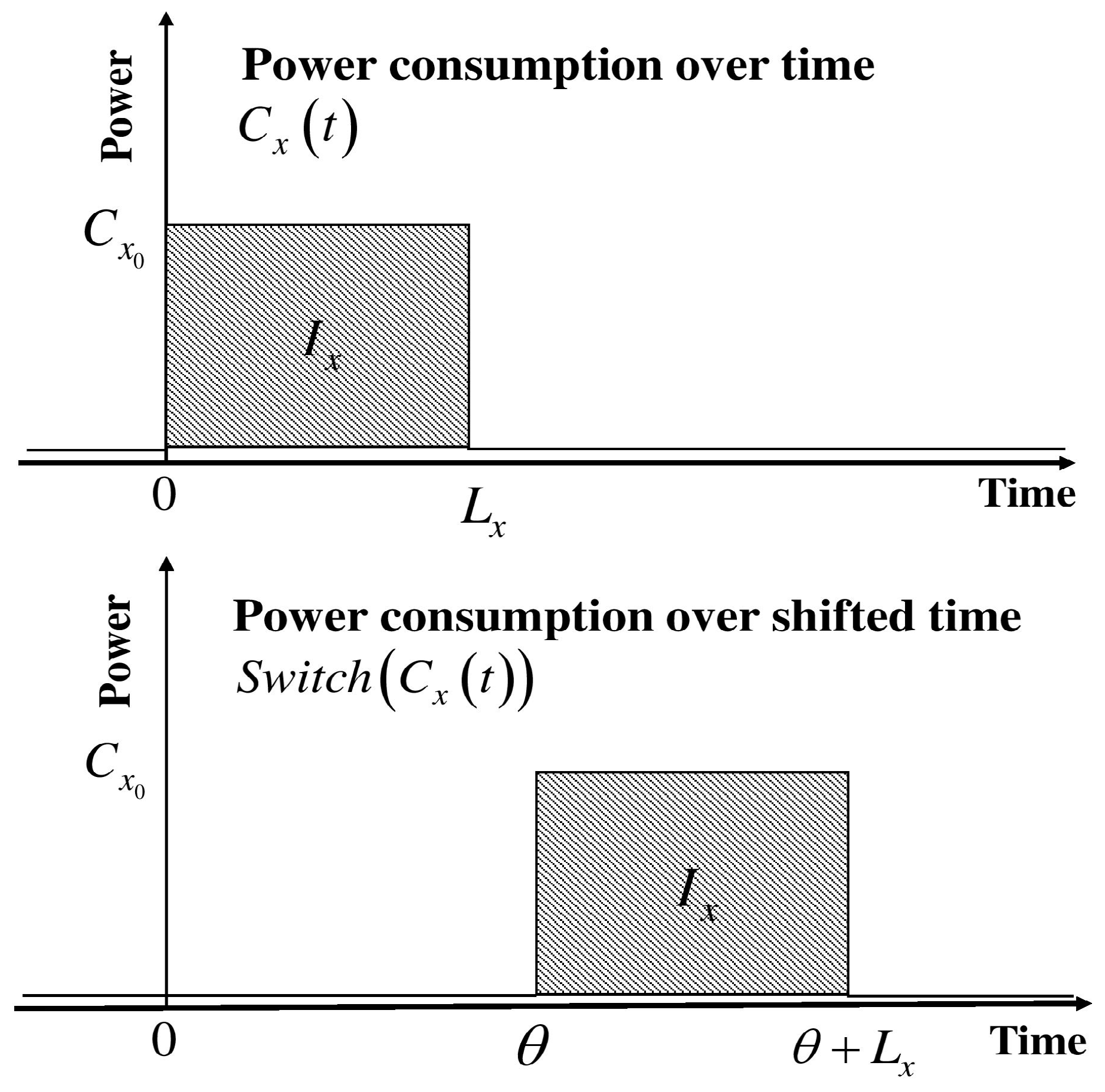

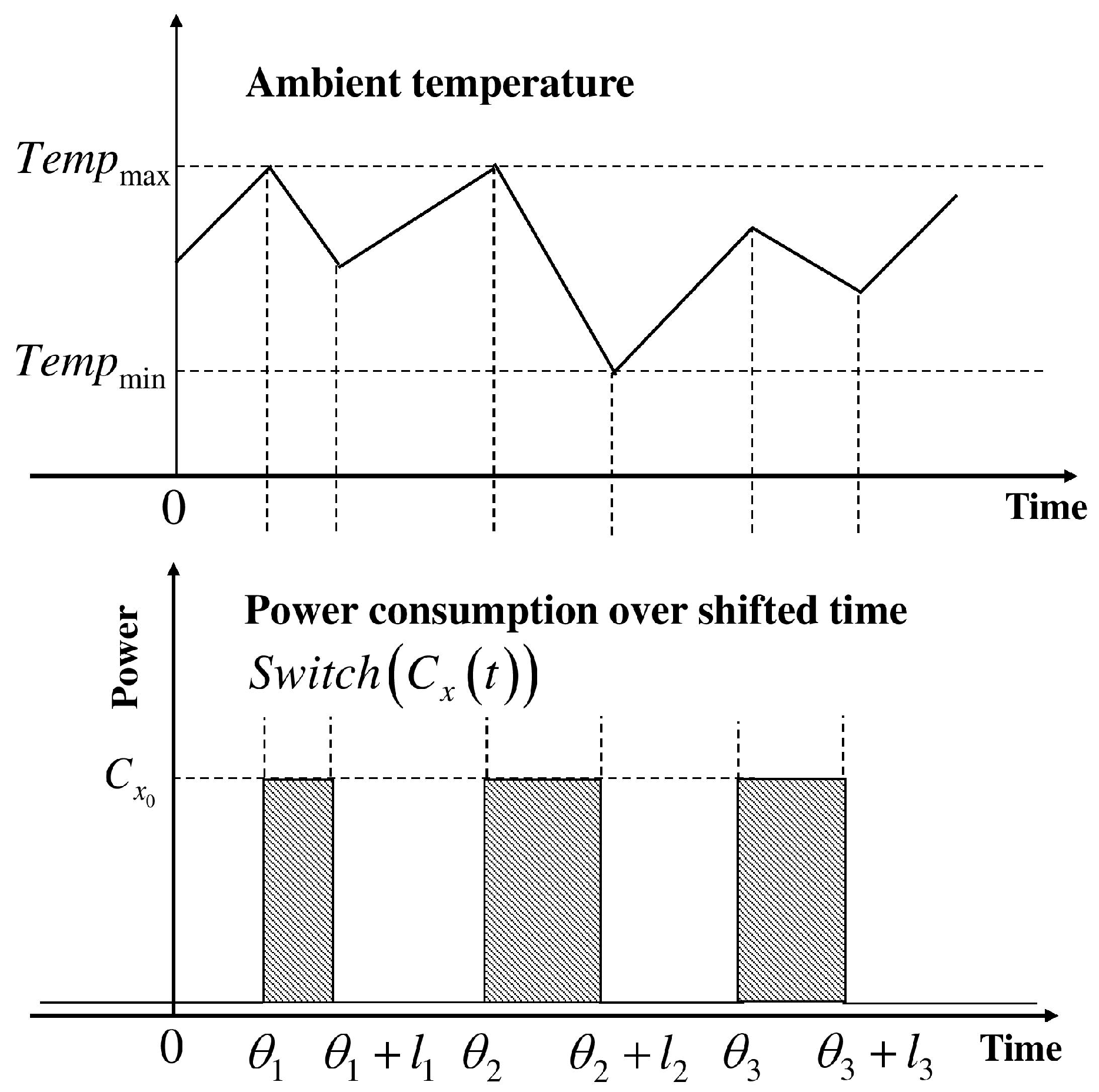

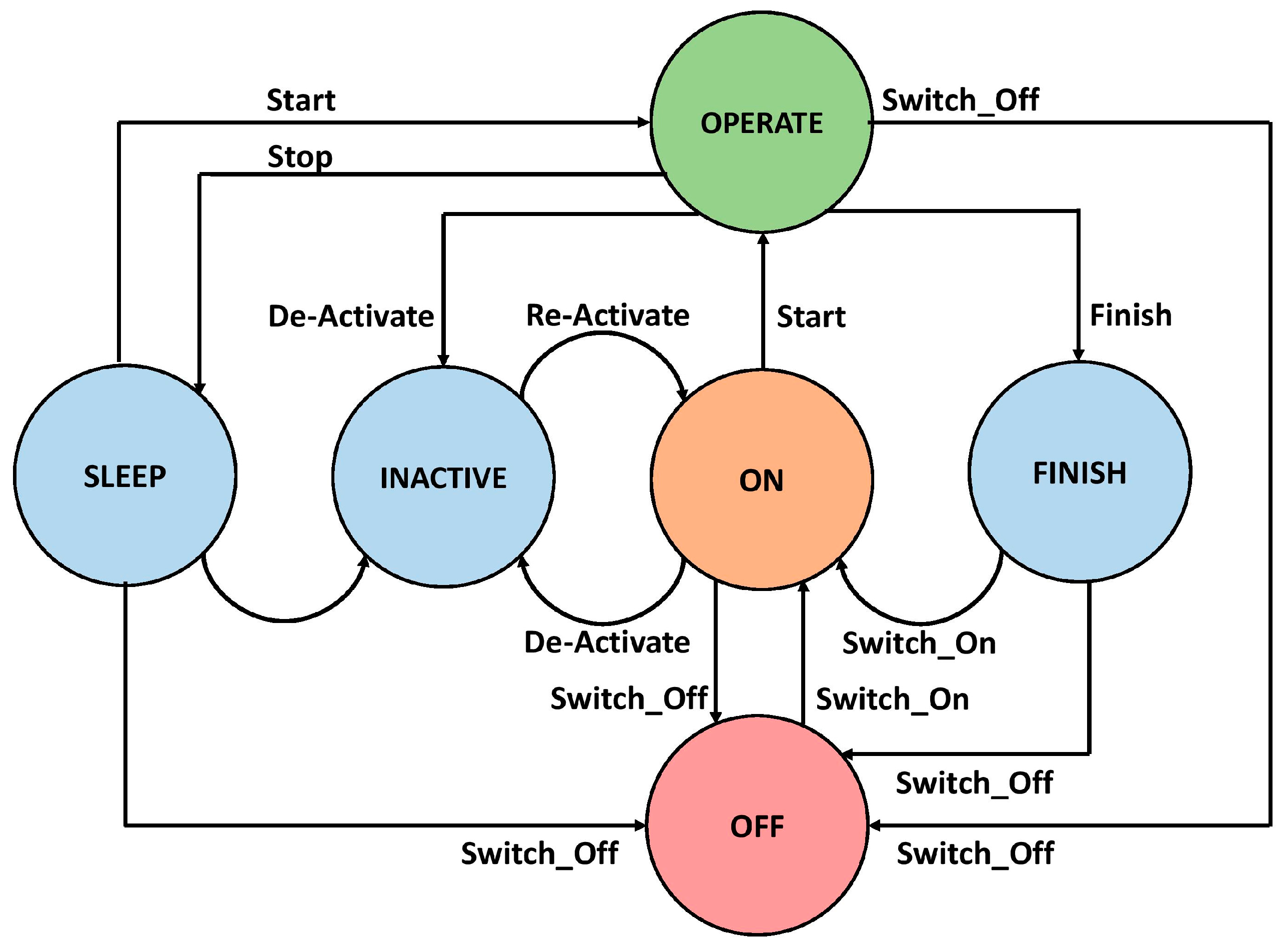

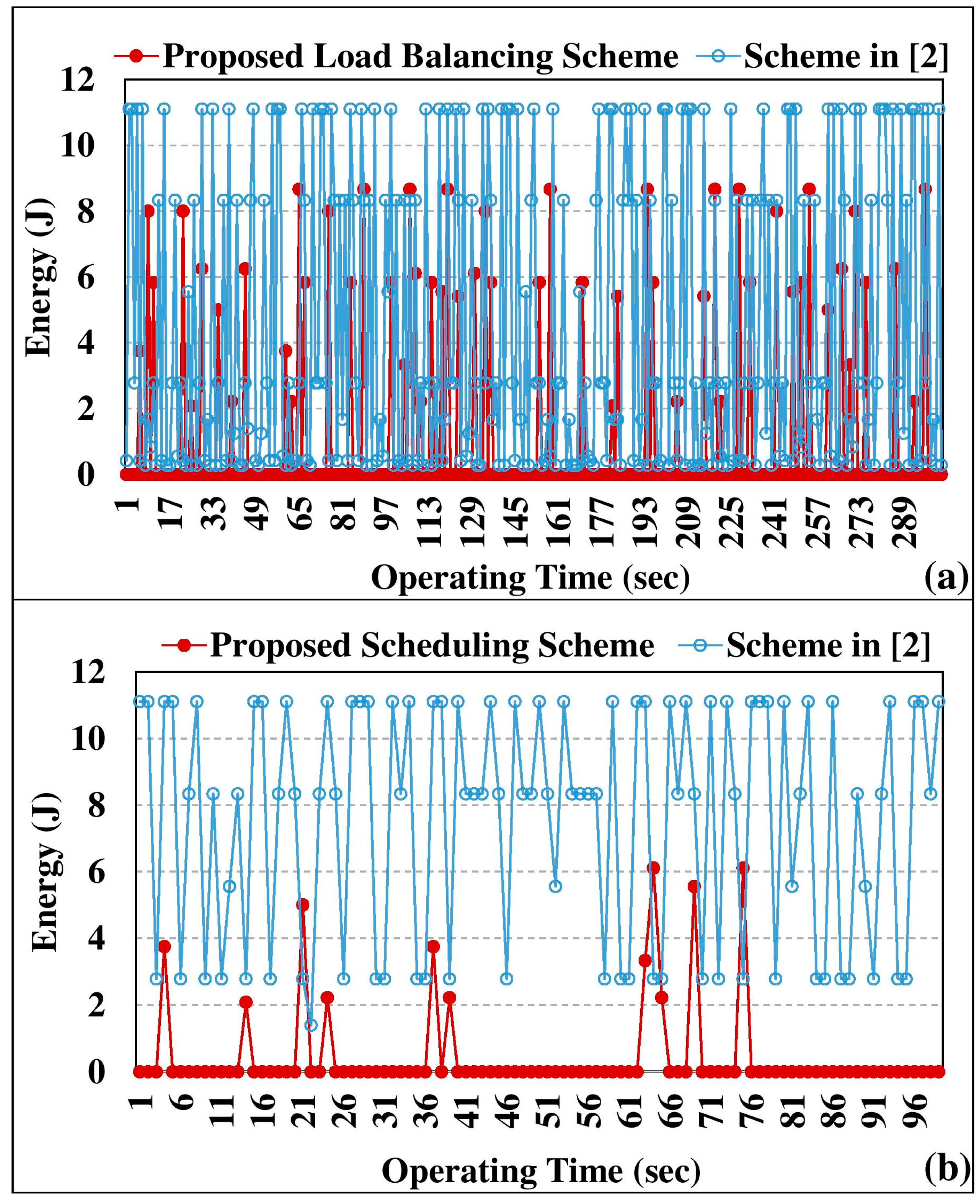
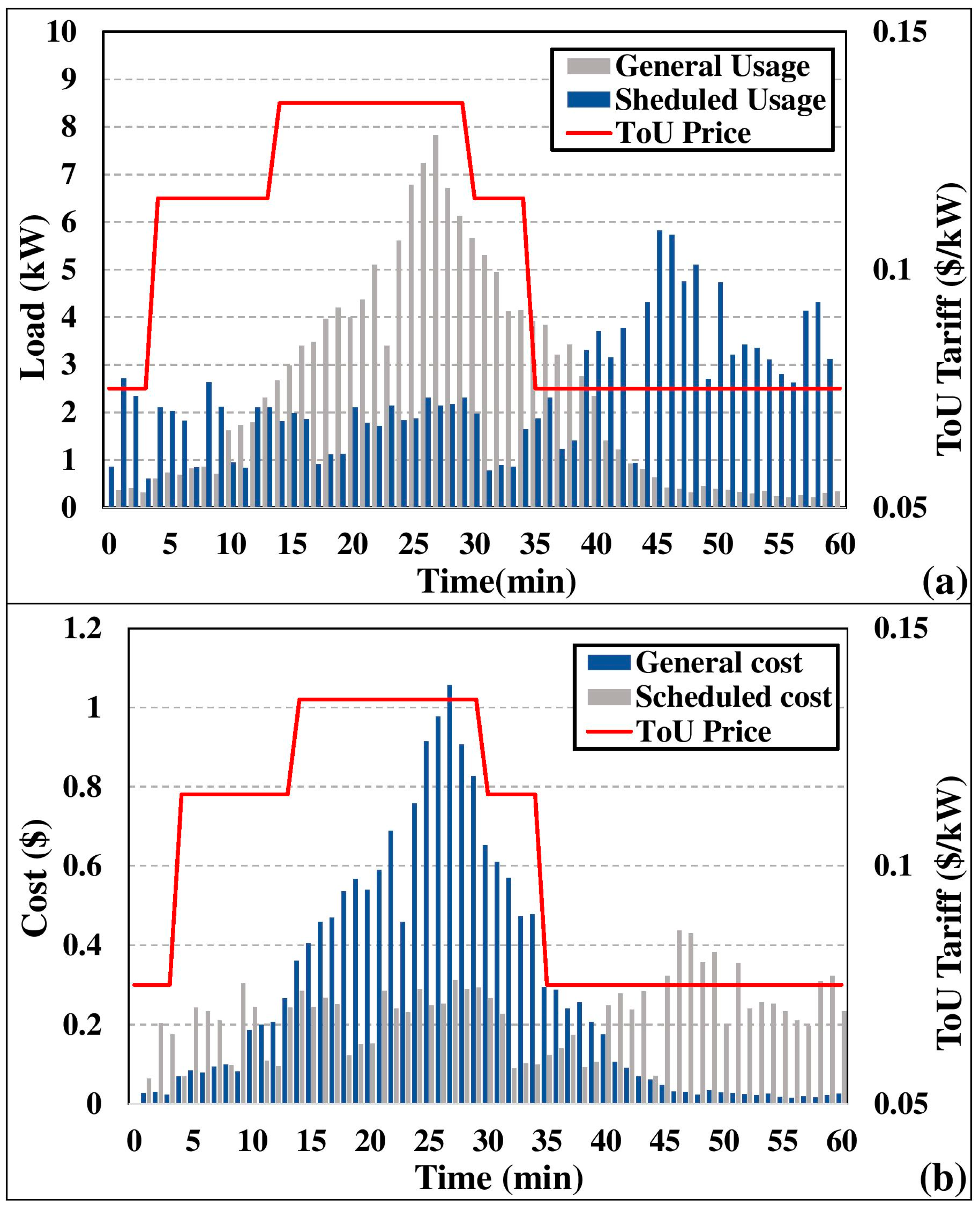
| State | Description |
|---|---|
| OFF | The appliance is turned off |
| ON | The appliance is ready to be operational |
| FINISH | The appliance has completed the assigned task |
| OPERATIONAL | The appliance is currently performing a task |
| SLEEP | The appliance is in SLEEP mode due to an interruption or urgent task |
| INACTIVE | The appliance is disabled for operations |
© 2018 by the authors. Licensee MDPI, Basel, Switzerland. This article is an open access article distributed under the terms and conditions of the Creative Commons Attribution (CC BY) license (http://creativecommons.org/licenses/by/4.0/).
Share and Cite
Silva, B.N.; Khan, M.; Han, K. Load Balancing Integrated Least Slack Time-Based Appliance Scheduling for Smart Home Energy Management. Sensors 2018, 18, 685. https://doi.org/10.3390/s18030685
Silva BN, Khan M, Han K. Load Balancing Integrated Least Slack Time-Based Appliance Scheduling for Smart Home Energy Management. Sensors. 2018; 18(3):685. https://doi.org/10.3390/s18030685
Chicago/Turabian StyleSilva, Bhagya Nathali, Murad Khan, and Kijun Han. 2018. "Load Balancing Integrated Least Slack Time-Based Appliance Scheduling for Smart Home Energy Management" Sensors 18, no. 3: 685. https://doi.org/10.3390/s18030685




